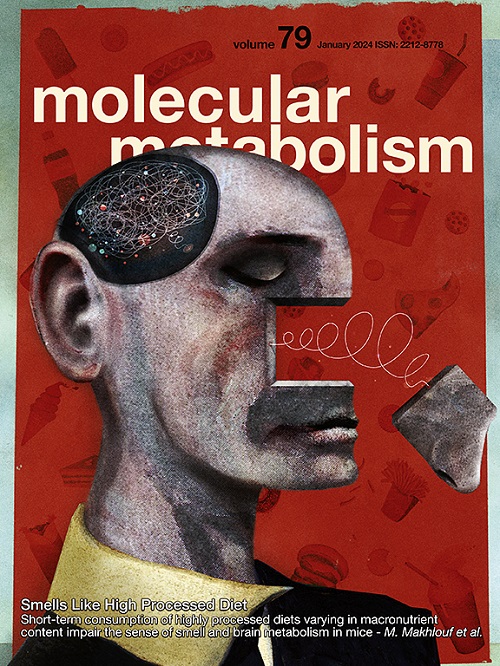DYRK1A inhibition restores pancreatic functions and improves glucose metabolism in a preclinical model of type 2 diabetes
IF 6.6
2区 医学
Q1 ENDOCRINOLOGY & METABOLISM
引用次数: 0
Abstract
Objectives
Insulin deficiency caused by the loss of β cells and/or impaired insulin secretion is a key factor in the pathogenesis of type 2 diabetes (T2D). The restoration of β cell number and function is thus a promising strategy to combat diabetes. Dual-specificity tyrosine-regulated kinase 1A (DYRK1A) has been shown to regulate human β cell proliferation. DYRK1A inhibitors are potential therapeutic tools, due to their ability to induce β cell proliferation. However, their anti-diabetic effects in the complex setting of type 2 diabetes remains unexplored. The aim of this study was to determine the impact of chronic DYRK1A inhibition on the remission of diabetes in pre-diabetic and overtly diabetic Goto-Kakizaki (GK) rats.
Methods
We assessed the impact of in vivo treatment with a DYRK1A inhibitor, Leucettinib-92, on β cell proliferation and insulin secretion in GK rats. Further, we evaluated the effects of long-term Leucettinib-92 treatment on the whole-body glucose metabolism in overtly diabetic GK rats through the assessment of fasting and post-absorptive glycemia, glucose tolerance and insulin sensitivity.
Results
Short-term in vivo treatment of prediabetic GK rats with Leucettinb-92 stimulated β cell proliferation in vivo, and sustainably prevented the development of overt hyperglycemia. Long-term treatment of adult GK rats with established diabetes increased the β cell mass and reduced basal hyperglycemia. Leucettinib-92 treatment also improved glucose tolerance, and glucose-induced insulin secretion in vivo.
Conclusions
We show that DYRK1A inhibition restores the β cell mass and function in a preclinical model of T2D, leading to the improvement of body's global glucose homeostasis.
DYRK1A抑制在2型糖尿病临床前模型中恢复胰腺功能并改善葡萄糖代谢
目的:由β细胞损失和/或胰岛素分泌受损引起的胰岛素缺乏是2型糖尿病(T2D)发病的关键因素。因此,β细胞数量和功能的恢复是对抗糖尿病的一种有希望的策略。双特异性酪氨酸调节激酶1A (DYRK1A)已被证明可调节人β细胞增殖。由于能够诱导β细胞增殖,DYRK1A抑制剂是潜在的治疗工具。然而,它们在复杂的2型糖尿病中的抗糖尿病作用仍未被探索。本研究的目的是确定慢性DYRK1A抑制对糖尿病前期和糖尿病公开性Goto-Kakizaki (GK)大鼠糖尿病缓解的影响。方法:研究DYRK1A抑制剂Leucettinib-92在体内对GK大鼠β细胞增殖和胰岛素分泌的影响。此外,我们通过评估空腹和吸收后血糖、葡萄糖耐量和胰岛素敏感性来评估长期Leucettinib-92治疗对明显糖尿病GK大鼠全身糖代谢的影响。结果:Leucettinb-92在体内短期治疗糖尿病前期GK大鼠,可刺激体内β细胞增殖,持续抑制明显高血糖的发生。患有糖尿病的成年GK大鼠长期治疗可增加β细胞质量并降低基础高血糖。Leucettinib-92治疗也改善了体内葡萄糖耐量和葡萄糖诱导的胰岛素分泌。结论:在临床前T2D模型中,DYRK1A抑制可恢复β细胞质量和功能,从而改善机体整体葡萄糖稳态。
本文章由计算机程序翻译,如有差异,请以英文原文为准。
求助全文
约1分钟内获得全文
求助全文
来源期刊

Molecular Metabolism
ENDOCRINOLOGY & METABOLISM-
CiteScore
14.50
自引率
2.50%
发文量
219
审稿时长
43 days
期刊介绍:
Molecular Metabolism is a leading journal dedicated to sharing groundbreaking discoveries in the field of energy homeostasis and the underlying factors of metabolic disorders. These disorders include obesity, diabetes, cardiovascular disease, and cancer. Our journal focuses on publishing research driven by hypotheses and conducted to the highest standards, aiming to provide a mechanistic understanding of energy homeostasis-related behavior, physiology, and dysfunction.
We promote interdisciplinary science, covering a broad range of approaches from molecules to humans throughout the lifespan. Our goal is to contribute to transformative research in metabolism, which has the potential to revolutionize the field. By enabling progress in the prognosis, prevention, and ultimately the cure of metabolic disorders and their long-term complications, our journal seeks to better the future of health and well-being.
 求助内容:
求助内容: 应助结果提醒方式:
应助结果提醒方式:


